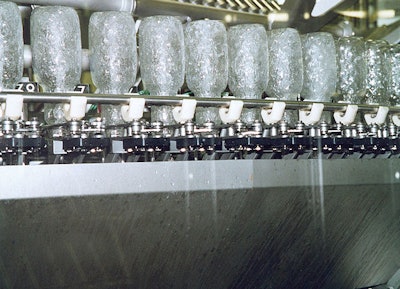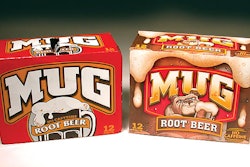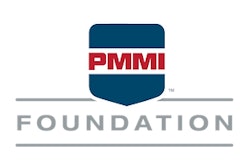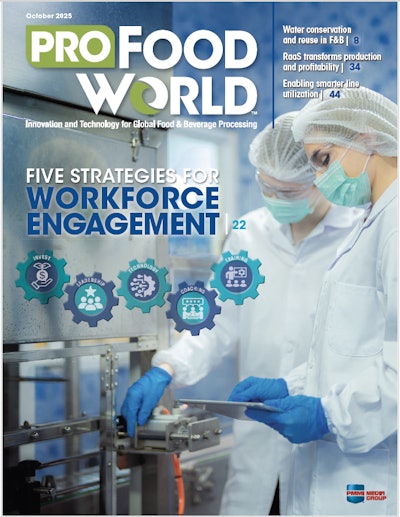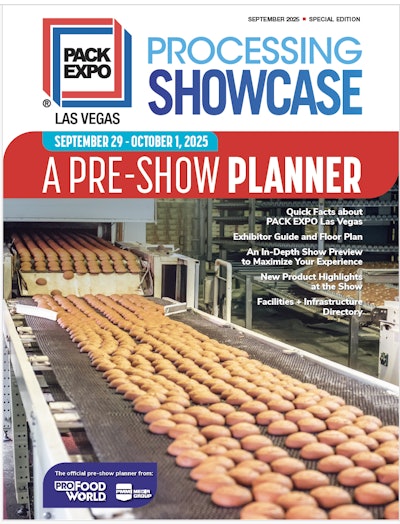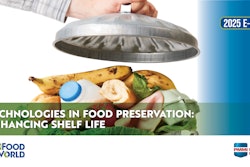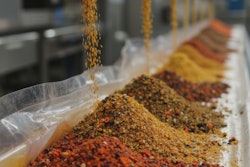Designed to fill 24ꯠ one-way-PET bottles/hr three shifts daily, the newest aseptic filling line at Eckes-Granini represents the latest in versatility, hygiene, and reliability.
Currently the Aseptic Cold Fill (ACF) line is used to fill fruit juices in only two sizes: .33- and 1-L. But it’s capable of filling sizes up to and including 1.5-L bottles. It was supplied by KHS.
“We view aseptic cold filling as the filling method of the future for nonrefillable PET,” says Eckes-Granini’s Hermann Naumann, plant manager at the Fallingbostel, Germany, plant where the new line runs. “We gathered a great deal of information on the state-of-the-art where such technology is concerned. Then we made our choice.”
Bottles are conveyed by air conveyor to the KHS sterilizing/filling/closing block. (Naumann chooses not to identify the number of stations involved in the three rotary units that perform rinsing, filling, and capping.) A two-lane air conveying system uses one lane to convey bottles with 28-mm neck finishes and the other for 38-mm neck finishes. Push-button changeover means a switch from one lane to another is accomplished quickly and efficiently.
Bottle exteriors are cleaned with a spray of paracetic acid solution just before they enter the sterilizing/filling/closing block. This entire block is enclosed in a glass-walled isolator surrounded by a sanitary room. The glass-walled isolator is sectioned off into several zones by safety partitions installed between the rinser and filler and the filler and capper. This reduces the risk of contamination that might enter one zone from reaching the other zones.
Air filters
The ceiling of the isolated filling room is covered with air filters that create a downward flow of sterile air. The sanitary room, too, is overpressured to keep contaminants from riding in on air currents.
Line disruptions are handled in one of two ways. Should a malfunction occur inside the glass-enclosed isolator, an operator in clean-room garb enters the sanitary room and uses glove ports in the glass walls of the isolator to try to fix whatever’s amiss. If he’s successful, filling can resume immediately, because asepsis has not been broken. As he exits the sanitary room that surrounds the isolator, it’s sprayed automatically with disinfectant.
If the problem can’t be resolved through the glove ports, the operator, again in clean-room garb, enters the sanitary room and the protective glass panels of the isolator are removed. The operator corrects the problem wearing sanitary gloves. The problem area is then disinfected by hand and the glass panels of the isolator are repositioned. After the operator has returned to the control room, automatic exterior disinfection of all pertinent machine surfaces and the interior walls of the glass isolator is carried out for a period of several minutes. Production is resumed upon completion of the disinfection process.
Rinsing
A triple-channel rinser is used to spray the inside of each bottle with paracetic acid, sterile water, and sterile air. The rinsing zones and times and the concentration levels of paracetic acid are subject to what KHS calls “an integrated monitoring systems check” in each individual rinsing station. Details on how this bit of technology functions are not available from KHS. But however it works, if anything in the rinsing process falls outside of predetermined parameters, that bottle is kicked off the line before it reaches the filling station.
According to Naumann, paracetic acid levels are kept to a minimum.
“Due to the high level of security incorporated in the overall concept, KHS has enabled us to use a paracetic acid concentration level of approximately 500 ppm for the rinsing process,” says Naumann. Not only does that keep costs in check, it also increases the useful life of the machinery, says Naumann.
Bottles move from rinser to the Innofill DNVF inductive flow meter filler by way of a transfer starwheel. Bottom-up filling through long fill tubes provides a gentle filling process, which in turn minimizes oxygen pickup, always a good thing where sensitive fruit juices are involved.
The capper installed at Eckes-Granini is the newly developed KHS Innofill SV-ACF. Designed especially for aseptic packaging, it’s characterized by its simple hygienic design. Also significant is that each capping station is independent of the overall machine speed because it’s driven by its own servo drive. That provides constant torquing feedback to the main PLC and minimizes time-consuming mechanical adjustments that have to be made when cap size changes.
Caps are sterilized in an enclosed channel in much the same way that bottles are: paracetic acid rinse is followed by sterile water and then sterile air to blow the caps dry.
As filled and capped bottles exit the glass-walled isolator and the overpressured sanitary room that surrounds it, they’re shrinkwrapped and palletized on equipment that is also supplied by KHS.
Peter Eugen Eckes, a co-partner of Eckes AG, describes the new line as “A step taken towards the future. High-quality products in convenient packages at a reasonable price—that’s convincing. Eckes-Granini takes new avenues in a consumer-oriented market with a performance package well thought out for its brands down to the last detail.” —PR
